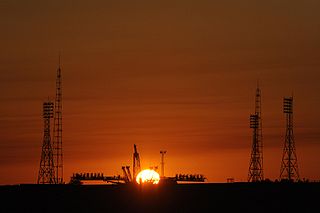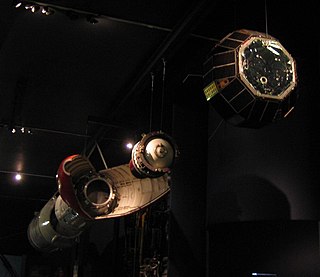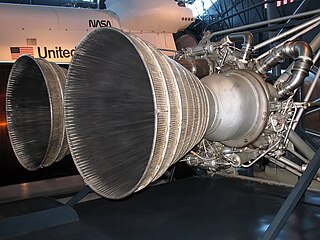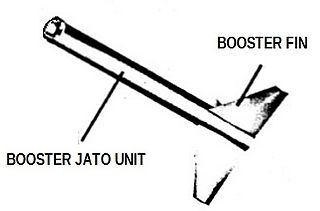Related Research Articles

A rocket is a missile, spacecraft, aircraft or other vehicle that obtains thrust from a rocket engine. Rocket engine exhaust is formed entirely from propellant carried within the rocket. Rocket engines work by action and reaction and push rockets forward simply by expelling their exhaust in the opposite direction at high speed, and can therefore work in the vacuum of space.

A solid-propellant rocket or solid rocket is a rocket with a rocket engine that uses solid propellants (fuel/oxidizer). The earliest rockets were solid-fuel rockets powered by gunpowder; they were used in warfare by the Chinese, Indians, Mongols and Persians, as early as the 13th century.

Titan was a family of United States expendable rockets used between 1959 and 2005. Titan I and Titan II were part of the US Air Force's intercontinental ballistic missile fleet until 1987. The space launch vehicle versions contributed the majority of the 368 Titan launches, including all the Project Gemini crewed flights of the mid-1960s. Titan vehicles were also used to lift US military payloads as well as civilian agency intelligence-gathering satellites and to send highly successful interplanetary scientific probes throughout the Solar System.

A spaceport or cosmodrome is a site for launching spacecraft, by analogy to seaport for ships or airport for aircraft. The word spaceport, and even more so cosmodrome, has traditionally been used for sites capable of launching spacecraft into orbit around Earth or on interplanetary trajectories. However, rocket launch sites for purely sub-orbital flights are sometimes called spaceports, as in recent years new and proposed sites for suborbital human flights have been frequently referred to or named 'spaceports'. Space stations and proposed future bases on the moon are sometimes called spaceports, in particular if intended as a base for further journeys.

The Aerobee rocket family was one of the outstanding achievements of early American rocketry. It not only was a primary sounding rocket of the 1940s and 1950s; Aerobees were launched into the mid-1980s with the last flight in 1985. The early RTV-N-10 Aerobee was a 6.14m unguided sounding rocket used for high atmospheric and cosmic radiation research in the United States in the 1940s. The Aerojet designation for the first Aerobees was XASR-1 which was also the designation of its engine. The name was a contraction of Aerojet and Bumblebee, the names of the prime contractor and manufacturer of the engine and Bumblebee a Navy guided missile program. As with its progenitor WAC Corporal the Aerobee required a large launch tower for initial guidance. The Aerobee was the first rocket fired by the US Navy at White Sands. Aerobee was boosted by a 2.5KS-18000 (X103C10) solid rocket. Aerobee was initially powered by the XASR-1 a version of the 21AL-2600 engine of the Nike Ajax. That engine was replaced by developed versions such as the AJ10-25 and AJ10-34. The Aerobee was the subject of the first comprehensive missile range safety program. The US Navy designation was RTV-N-8. The US Air Force also operated Aerobees under program MX-1011 as X-8 (RTV-A-1). The USAF system of fuel tank pressurization with helium instead of compressed air was adapted by the USN and the Navy Aerobee was redesignated RTV-N-10.

The Black Brant is a family of Canadian-designed sounding rockets originally built by Bristol Aerospace, since absorbed by Magellan Aerospace in Winnipeg, Manitoba. Over 800 Black Brants of various versions have been launched since they were first produced in 1961, and the type remains one of the most popular sounding rockets ever built. They have been repeatedly used by the Canadian Space Agency and NASA.

Titan IV was a family of heavy-lift space launch vehicles developed by Martin Marietta and operated by the United States Air Force from 1989 to 2005. Launches were conducted from Cape Canaveral Air Force Station, Florida and Vandenberg Air Force Base, California.

The Titan IIIC was an expendable launch system used by the United States Air Force from 1965 until 1982. It was the first Titan booster to feature large solid rocket motors and was planned to be used as a launcher for the Dyna-Soar, though the spaceplane was cancelled before it could fly. The majority of the launcher's payloads were DoD satellites, for military communications and early warning, though one flight (ATS-6) was performed by NASA. The Titan IIIC was launched exclusively from Cape Canaveral while its sibling, the Titan IIID, was launched only from Vandenberg AFB.

Atlas II was a member of the Atlas family of launch vehicles, which evolved from the successful Atlas missile program of the 1950s. It was designed to launch payloads into low earth orbit, geosynchronous transfer orbit or geosynchronous orbit. Sixty-three launches of the Atlas II, IIA and IIAS models were carried out between 1991 and 2004; all sixty-three launches were successes, making the Atlas II the most reliable launch system in history. The Atlas line was continued by the Atlas III, used between 2000 and 2005, and the Atlas V which is still in use.

The MGR-1 Honest John rocket was the first nuclear-capable surface-to-surface rocket in the United States arsenal. Originally designated Artillery Rocket XM31, the first unit was tested on 29 June 1951, with the first production rounds delivered in January 1953. Its designation was changed to M31 in September 1953. The first Army units received their rockets by year's end and Honest John battalions were deployed in Europe in early 1954. Alternatively, the rocket was capable of carrying an ordinary high-explosive warhead weighing 1,500 pounds (680 kg).

The Scout family of rockets were American launch vehicles designed to place small satellites into orbit around the Earth. The Scout multistage rocket was the first orbital launch vehicle to be entirely composed of solid fuel stages. It was also the only vehicle of that type until the successful launch of the Lambda 4S in 1970.

North Truro is a village in the town of Truro, Massachusetts, United States. Due to its proximity to urbanized Provincetown, it is somewhat more densely developed than the rest of the town, with houses and small resort facilities lining the two main thoroughfares, U.S. Route 6 and MA Route 6A. It is home to Truro Vineyards, one of two operating wineries on Cape Cod. North Truro is located at 42°03′35″N70°08′31″W.

ASP, (Atmospheric Sounding Projectile is the designation of an American sounding rocket family. ASP-I was used to sample nuclear explosions and resultant clouds The ASP was the fastest single stage sounding rocket when developed.. The Asp was manufactured by Cooper Development Corporation, California. The solid propellant motor was made by Grand Central Rocket company.

The Saturn II was a series of American expendable launch vehicles, studied by North American Aviation under NASA contract in 1966, derived from the Saturn V rocket used for the Apollo lunar program. The intent of the study was to eliminate production of the Saturn IB, and create a lower-cost heavy launch vehicle based on Saturn V hardware. North American studied three versions with the S-IC first stage removed: the INT-17, a two-stage vehicle with a low Earth orbit payload capability of 47,000 pounds (21,000 kg); the INT-18, which added Titan UA1204 or UA1207 strap-on solid rocket boosters, with payloads ranging from 47,000 pounds (21,000 kg) to 146,400 pounds (66,400 kg); and the INT-19, using solid boosters derived from the Minuteman missile first stage.

Waxwing was a British solid rocket motor used for apogee kick as the 3rd (upper) stage of the Black Arrow satellite launch vehicles. Waxwing was used to successfully place the Prospero X-3 satellite into low Earth orbit on 28 October 1971, Britain's only satellite launch on an indigenously-developed launch vehicle.
Operation Have Horn was a project in 1969 by the United States Air Force that involved the launching of Nike Hydac sounding rockets. It occurred at North Truro Air Force Station, located in North Truro, Massachusetts. Upon completion of the operation in 1970, the used devices were returned to the White Sands Missile Range, in New Mexico. Have Horn was support and carried out by the Missile and Drone Division of the Air Force Missile Development Center, Holloman Air Force Base, New Mexico.

The LR87 was an American liquid-propellant rocket engine, which was used on the first stages of Titan intercontinental ballistic missiles and launch vehicles. Composed of twin motors with separate combustion chambers and turbopump machinery, it is considered a single unit. The LR87 first flew in 1959.
The Star is a family of US solid-propellant rocket motors used by many space propulsion and launch vehicle stages. They are used almost exclusively as an upper stage, often as an apogee kick motor.

The Nike stage or Nike booster, a solid fuel rocket motor, was created by Hercules Aerospace for the Nike Ajax (M5) Nike Hercules (M5E1). It was developed for use as the first stage of the Nike Ajax and Nike Hercules missiles as part of Project Nike.
Nike Yardbird was an American sounding rocket with two stages, based upon the Nike Hercules M5E1 booster and a Thiokol TE-289 Yardbird upper stage. Yardbird was an improved Thiokol XM-19 motor. The Nike Yardbird was launched 2 times from Wallops Island on Sphere Test aeronomy missions both of which were classified as failures. Information available doess not state the reason for the mission failures but Astronautix lists the apogee of both missions as 10 km which is well below the goal of 120 km.
References
- 1 2 astronautix.com: Nike Hydac Archived 2003-09-05 at the Wayback Machine
- ↑ astronautix.com: Air Force Cambridge Research Lab Archived 2011-03-03 at the Wayback Machine
| This rocketry article is a stub. You can help Wikipedia by expanding it. |